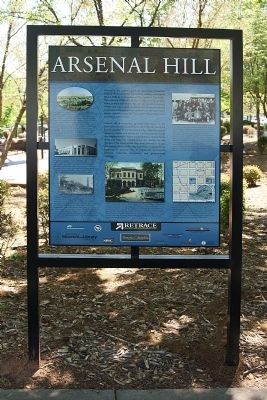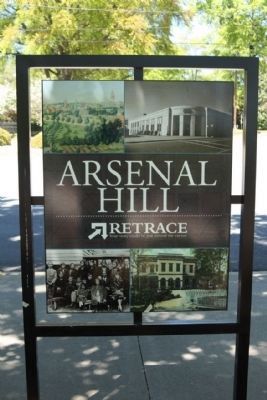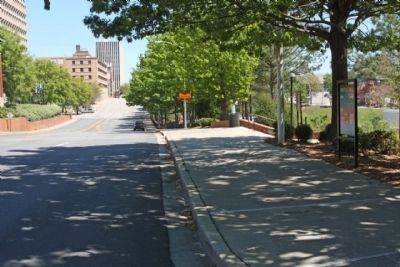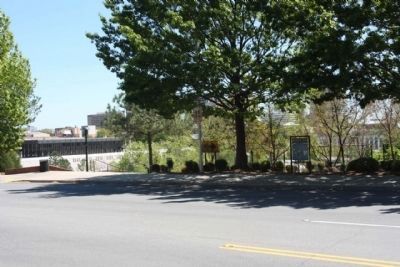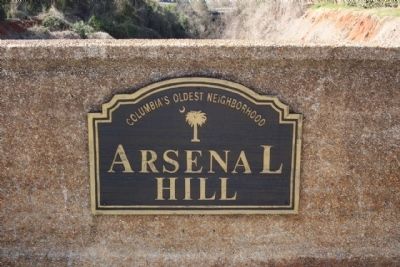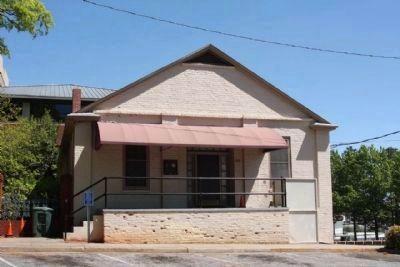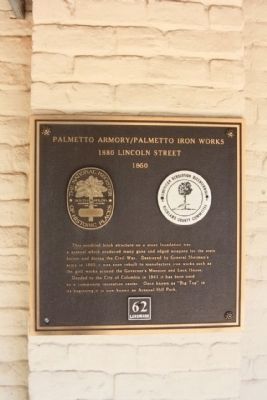Arsenal Hill in Columbia in Richland County, South Carolina — The American South (South Atlantic)
Arsenal Hill
Arsenal Hill is recognized by many Columbians as the home of the South Carolina Governor's Mansion and as the former location of the Palmetto Armory, which produced weaponry before and during the Civil War. Some identify the neighborhood as home for generations of their family, living and departed. Others know the district for the changes it has experienced over time. Diverse in its past and present, Arsenal Hill today is an historic neighborhood featuring an eclectic mix of residential, commercial, religious, industrial, educational, and governmental buildings.
Erected by Historic Columbia Foundation, Institute of Museum and Library Services, City of Columbia.
Topics. This historical marker is listed in this topic list: Notable Places. A significant historical year for this entry is 1842.
Location. 34° 0.479′ N, 81° 2.477′ W. Marker is in Columbia, South Carolina, in Richland County. It is in Arsenal Hill. Marker is on Laurel Street near Lincoln Street, on the right when traveling east. Touch for map. Marker is in this post office area: Columbia SC 29201, United States of America. Touch for directions.
Other nearby markers. At least 8 other markers are within walking distance of this marker. Palmetto Arsenal / Iron Works (about 300 feet away, measured in a direct line); Site of Palmetto Iron Works (about 500 feet away); Philip Simmons (about 600 feet away); The Gonzales Fountain (about 700 feet away); Lord John Berkeley (about 700 feet away); Lord Ashley (about 700 feet away); Sir John Colleton (about 700 feet away); Boylston House & Boxwood Gardens (about 700 feet away). Touch for a list and map of all markers in Columbia.
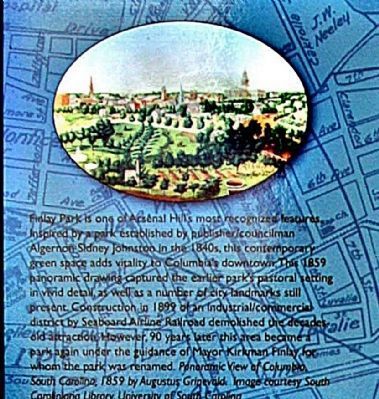
Photographed By Arsenal Hill Marker
3. Upper left picture
Finley Park is one of Arsenal Hills most recognized features.
Inspired by a park established by publisher/councilman
Algernon Sidney Johnston in the 1840s, this contemporary
green space adds vitality to Columbia's downtown. This 1859
panoramic drawing captured the earlier park's pastoral setting
in vivid detail as well as a number of city landmarks still
present. Construction in 1899 of an industrial/commercial
district by Seaboard Airline Railroad demolished the decades
old attraction. However, 90 years later this area became a
park again under the guidence of Mayor Kirkman Finley for
whom the park was renamed. Panaramic View of Columbia
South Carolina, 1859, by Augustus Grinevald. Image courtesy South
Caroliniana Library,University of South Carolina.
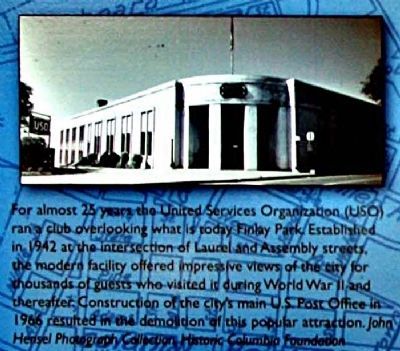
Photographed By Arsenal Hill Marker
4. Middle left picture
For almost 25 years the United Services Organization (USO) [Picture included]
ran a club overlooking what is today Finlay Park. Established
in 1942 at the intersection of Laurel and Assembly streets,
the modern facility offered impressive views of the city for
thousands of guests who visited it during World War II and
thereafter. Construction of the city's main U.S. Post Office in
1966 resulted in the demolition of this popular attraction. John
Heusel Photograph Collection Historic Columbia Foundation.
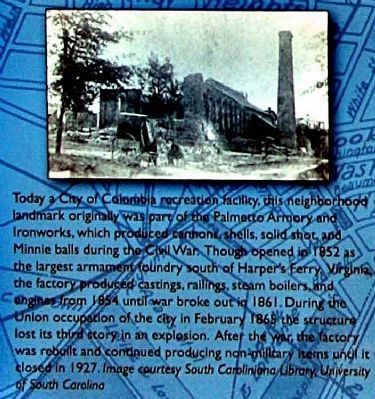
Photographed By Arsenal Hill Marker
5. Lower left picture
Today a City of Columbia recreation facility, this neighborhood
landmark originally was part of the Palmetto Armory and
Ironworks, which produced cannons, shells, solid shot, and
Minnie balls during the Civil War. Though opened in 1852 as
the largest armament foundry south of Harpers Ferry, Virginia,
the factory produced castings, railings, steam boilers, and
engines from 1854 until war broke out in 1861. During the
Union occupation of the city in February 1865 the structure
lost its third story in an explosion. After the war, the factory
was rebuilt And continued producing non-military items until it
closed in 1927. Image courtesy South Caroliniana Library, University
of South Carolina.
** See nearby markers
** See nearby markers

Photographed By Arsenal Hill Marker
6. Lower picture
With its storied past, the South Carolina Governor's Mansion has long been a popular
subject for postcards, including this example from 1915. Constructed in 1855 as
an officers "tenement" for Arsenal Academy, the building miraculously survived the
burning of Columbia unlike the rest of the institution's campus. Following the war, in
1869, the State rehabilitated the former quarters for the use as the Governor's Mansion.
Today's Governor's Mansion complex includes two additional antebellum structures,
the circa- 1855 Lace House and the circa- 1825 Caldwell-Bolyston House. Historic
Columbia Foundation collection
** See nearby markers
** See nearby markers
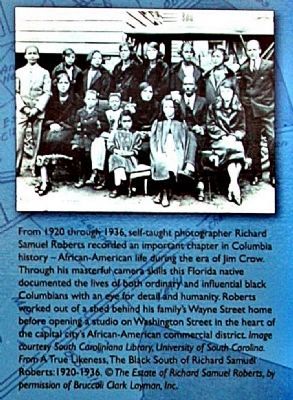
Photographed By Arsenal Hill Marker
7. Upper right picture
From 1920 through 1936, self-taught photographer Richard
Samuel Roberts recorded an important chapter in Columbia
history - African-American life during the era of Jim Crow.
Through his masterful cameraskills this Florida native
documented the lives of both ordinary and influential black
Columbians with an eye for detail and humanity. Roberts
worked out of a shed behind his family's Wayne Street home
before opening a studio on Washington Street. in the heart of
the capital city's African-American commercial district. Image
courtasy South Caroliniana Library, University of South Carolina.
From A True Likeness, The Black South of Richard Samuel
Roberts: 1920-1936.© The Estate of Richard Samuel Roberts,
by permission of Bruccali Clark Layman, Inc.
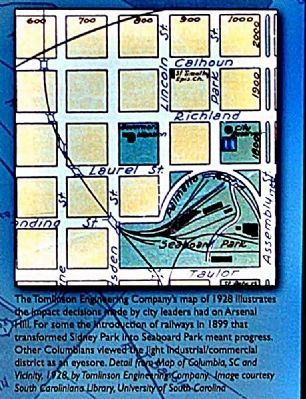
Photographed By Arsenal Hill Marker
8. Lower right picture
The Tomlinson Engineering Company's Map of 1928
illustrates the impact decisions made by city leaders had on Arsenal Hill.
For some the introduction of railways in 1899 that transformed Sidney Park
into Seaboard Park meant progress. Other Columbians viewed the light
industrial/commercial district as an eyesore. Detail from map of
Columbia, SC and Vicinity, 1928 by Tomlinson Engineering Company;
Image courtasy South Caroliniana Library, University of South Carolina.
Credits. This page was last revised on February 16, 2023. It was originally submitted on April 12, 2011, by Mike Stroud of Bluffton, South Carolina. This page has been viewed 849 times since then and 26 times this year. Photos: 1, 2, 3, 4, 5, 6, 7, 8, 9, 10, 11, 12, 13. submitted on April 12, 2011, by Mike Stroud of Bluffton, South Carolina.
